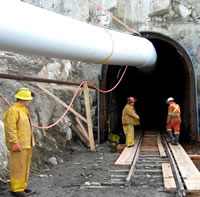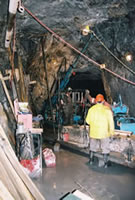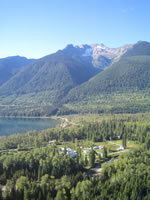 |  |
The MAX Molybdenum Project - "a Company-builder"
 MAX has been the subject of a significant exploration and engineering program conducted by Newmont Mines Ltd. and Esso Minerals Canada Ltd. in the late 1970's and early 1980's. Despite the extent and quality of the previous work, the project was never put in production by the joint venture. MAX has been the subject of a significant exploration and engineering program conducted by Newmont Mines Ltd. and Esso Minerals Canada Ltd. in the late 1970's and early 1980's. Despite the extent and quality of the previous work, the project was never put in production by the joint venture.Fast-track Mining Opportunity As a result of previous operators' $15 million effort at MAX, the project boasts a large production-sized access adit and a comprehensive geological, engineering and environmental database. The high-grade zones and existing access at MAX provide an opportunity for fast-tracked production. Roca retained Hatch Associates Ltd., to conduct independent engineering studies and preliminary economic assessments for a 500 tonne per day operation at the MAX Project (MAX Molybdenum Project Preliminary Assessment). These preliminary economic cost estimates and financial models were further refined by Roca and its consultants resulting in the filing of an application for a British Columbia "Small Mines Permit" in the name of Roca's wholly-owned operating subsidiary, FortyTwo Metals Inc. In November 2005, FortyTwo Metals was granted a production permit from the British Columbia Ministry of Energy, Mines and Petroleum Resources. Initial production will focus on the rich, "HG Zone" within the centre of the "B-Zone" to produce a readily saleable premium specification concentrate of approximately 95% MoS2. Roca Mines Inc.'s wholly owned subsidiary, FortyTwo Metals Inc., purchased a 1,000-tonne-per-day mill and concentrator and related equipment for the MAX molybdenum project. The mill is located approximately 380 highway kilometres (230 miles) south of the MAX site. The company plans to dismantle and move the mill, including; buildings, crushing, grinding and flotation circuits. Importantly, complete engineering drawings for the mill buildings and equipment will allow for rapid reconstruction at the MAX site. The initial phase of mining is expected to produce approximately 1.5 million lbs of contained molybdenum from each production run of 72,000 tonnes. In 2007, Roca intends to complete back-to-back production runs resulting in the production of approximately 3.0 million lbs of contained molybdenum. Total annual operating costs (mine, mill and overhead) are estimated at US$7.2 million (approximately $100/tonne) with capital costs of approximately US$14 million. Payback of start-up capital is approximately 9 months from construction startup or 4 months from mill startup. Using a campaigned mining-milling approach, Roca plans to recover much of the 260,000 tonnes of 1.95% MoS2 within the first few years of production, and to make expansion decisions based on prevailing molybdenum prices during 2007 and beyond.  Expansion potential - Large-scale Mining Expansion potential - Large-scale MiningWith total cash costs conservatively estimated at US$100/tonne, the high grade zones within the deposit (see MAX Display Section) provide compelling economics down to a price of $5 for contained molybdenum in oxide, a luxury most pure molybdenite porphyry deposits do not share. As many metals analysts see molybdenum prices staying in the $10-$15 per pound range for years to come, Roca is advancing concepts for rapid expansion of the operation using internally generated cash-flow should molybdenum prices justify. Hatch has also prepared Roca's preliminary engineering studies for a 2,500 tpd bulk tonnage operation, based on the measured and indicated resource of 11,350,000 tonnes grading 0.36% MoS2 at a 0.20% MoS2 cutoff. Exploration and Bluesky  The global measured and indicated resource, 42,940,000 tonnes grading 0.20% MoS2 at a 0.10% MoS2 cutoff contains in excess of $3 billion contained metal value (at $30/lb molybdenum, not including any inferred resources) and remains open at depth. Future exploration will focus on expanding this resource both at depth and in areas surrounding the main deposit. An advisory board of porphyry molybdenum experts has been formed to guide the Company with further exploration plans at MAX. The global measured and indicated resource, 42,940,000 tonnes grading 0.20% MoS2 at a 0.10% MoS2 cutoff contains in excess of $3 billion contained metal value (at $30/lb molybdenum, not including any inferred resources) and remains open at depth. Future exploration will focus on expanding this resource both at depth and in areas surrounding the main deposit. An advisory board of porphyry molybdenum experts has been formed to guide the Company with further exploration plans at MAX.Several molybdenum deposit experts have pointed to the similarities between the MAX deposit and the URAD deposit (the uppermost deposit associated with the famous +700 million tonne Henderson deposit) owned and operated by Climax Molybdenum Company. Henderson has operated since 1976 as a primary molybdenum underground mine and should be a profitable operation for parent company Phelps Dodge Corporation for another 20 years. Climax started mining the relatively small (approx. 13.7 million tons of .35% MoS2) URAD orebody while geologists theorized that the deposit was an offshoot of a larger and deeper deposit. After several years of exploration, a 1965 deep drillhole tagged what is now the Henderson deposit within Red Mountain. 40 years later, the Henderson mine is operating at over 30,000 Tpd, making it one of the largest underground mines in the world. Could the 43 million tonne Max deposit be an upper offshoot of something much bigger lurking under Trout Mountain? Photos/Video Section � | |||||||||||||||||||||||||||||||||||||||||||
Corporate | News�Releases | Projects | Investor�Info | Contact�Us | RokReport | Disclaimer | Home � 2006 Roca Mines Inc. All Rights Reserved. |